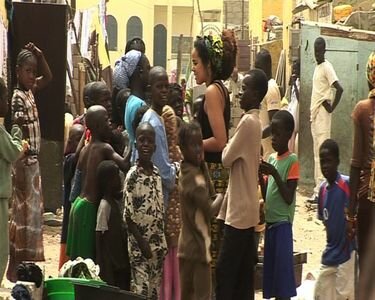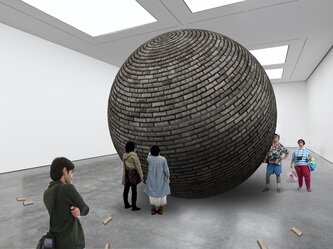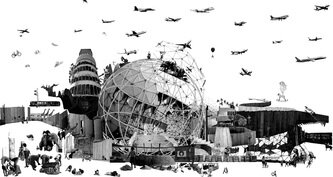"Family Tree" | 2011 | etching | Nathalie Mba Bikoro
The Brick Moon | Who Fell From The Sky | The Book series

The Brick Moon | Who Fell From The Sky sees the 2013 first release of a series of childrens' books based on Lewis Carroll's classic novel "The Adventures of Alice In Wonderland/Through The Looking Glass" and modern experiences of homeland and idenity familiar in Paul Cesaire's works on "the Return to My Native Homeland" and spaces of future modernities and new founded societies in Elverett Hale's short 1892 story "The Brick Moon". A complex construction of fractured time travel naratives across cultures, based on philosophical ideas of Gilles Deleuze's "The Logic of Senses", we follow a timeless protagonist, Alice, a little girl both young and old, black and white, girl and boy. She is the child from our neighbourhoods, she is a memory of our childhoods. Falling through the rabbit's hole, she leaves her mother and joins her father on a voyage suspended between tradition and modernity through imagination and reality which will enable her to construct her identities.
When I was growing up in Gabon, there were no availbale libraries or adequate books to read from. Books were being burned, torn apart, filled with old literatures of colonial France and our heroes were behind tv screens. Our journeys and imaginations were constructed amongst ourselves out of schools and away from our parents. 24 years later, nothing has changed; a history of imagination and inspirations for flight is missing, our heroes are hidden and our relations between each other is fractured amongst family, community and nation.
The book series is launched to bind these relationships between people, young and old, playgrounds, homes and schools. The aim of the book series is to be published and follow free distribution to schools across Gabon and have the story as a Gift for narration, re-enactment, performativity, relationship, dialogue and creativity. Later, we hope the books will be distributed across internationally including Africa, Latin America, Asia, Europe and USA.
The book series will be read by young people and parents, together with interviews on original characters with the development and inspirations for Alice's journey from home life in Gabon and abroad to the making in the studio, supported by an international programme series of printmaking, animation, writing and performance workshops lead by myself and international creative talents, and an interactive digital online game where you can follow Alice's journey.
This work includes a collaboration with digital artist Damian Harmata.
Where will donations go?
Donations & 50% of sales will go towards arts and cultural activities after schools and to creative self-development therapies workshops for young people in Bitam, Gabon run by DNA Arts Foundation. Additionally shares will be supporting 5 small independent organisations in cultural arts & education (ANO Ghana; St Louis Cinema & literature; Creative events in la Macarena Bogota; Arts school mediatheque Nairobi) and health (medical care for neglected children in South Poland).
Original sold etching prints from the Alice In Wonderland series will bring its proceeds towards the maintenance of libraries in schools and accessibility to education (art and litterature) in Gabon.
What rewards will donours get?
Donours will be rewarded by invitation to the cultural centre in Bitam or cultural centre in St Louis and share activities and develop own experiences and creativities; have the chance to bring their own stories, memories and journeys into the work of Alice by special commissions and featured in future book series; a free copy of the book; the chance to get their names published in the publication; workshops will be offered by the artist in guest international institutions; curatorial exchanges or opportunities are available for project supporters in developing exhibitions and events in Bitam or Gabon's Museum of Arts Libreville or St Louis in Senegal.
The book series is launched to bind these relationships between people, young and old, playgrounds, homes and schools. The aim of the book series is to be published and follow free distribution to schools across Gabon and have the story as a Gift for narration, re-enactment, performativity, relationship, dialogue and creativity. Later, we hope the books will be distributed across internationally including Africa, Latin America, Asia, Europe and USA.
The book series will be read by young people and parents, together with interviews on original characters with the development and inspirations for Alice's journey from home life in Gabon and abroad to the making in the studio, supported by an international programme series of printmaking, animation, writing and performance workshops lead by myself and international creative talents, and an interactive digital online game where you can follow Alice's journey.
This work includes a collaboration with digital artist Damian Harmata.
Where will donations go?
Donations & 50% of sales will go towards arts and cultural activities after schools and to creative self-development therapies workshops for young people in Bitam, Gabon run by DNA Arts Foundation. Additionally shares will be supporting 5 small independent organisations in cultural arts & education (ANO Ghana; St Louis Cinema & literature; Creative events in la Macarena Bogota; Arts school mediatheque Nairobi) and health (medical care for neglected children in South Poland).
Original sold etching prints from the Alice In Wonderland series will bring its proceeds towards the maintenance of libraries in schools and accessibility to education (art and litterature) in Gabon.
What rewards will donours get?
Donours will be rewarded by invitation to the cultural centre in Bitam or cultural centre in St Louis and share activities and develop own experiences and creativities; have the chance to bring their own stories, memories and journeys into the work of Alice by special commissions and featured in future book series; a free copy of the book; the chance to get their names published in the publication; workshops will be offered by the artist in guest international institutions; curatorial exchanges or opportunities are available for project supporters in developing exhibitions and events in Bitam or Gabon's Museum of Arts Libreville or St Louis in Senegal.
To support this literary project please follow this link.
coming soon..
coming soon..
Samples of the childrens' story book here
(translated in English, French, Fang, Portuguese, Spanish, Igbo, Swahili, German, Polish)
coming soon..
(translated in English, French, Fang, Portuguese, Spanish, Igbo, Swahili, German, Polish)
coming soon..
An interview wth Nathalie Mba Bikoro
debut documentary film by Pierre-Manau Ngoula (Congo) | filmed at the Dak'Art Biennale in Senegal | 2012
debut documentary film by Pierre-Manau Ngoula (Congo) | filmed at the Dak'Art Biennale in Senegal | 2012
The Story of The Brick Moon
The Brick Moon is a complex story about home, roots, religion, faiths, community and the Self.
It shows Alice amongst others from different lands, languages and religions. She looses her faith in the myth of Noah's Ark and struggles with the fear of the passage of the sea so she determinately constructs a Brick Moon, a little like the Tower of Babel that will enable her and all others (chosen or not) to sail across the sky and make star constellations which will give the way home to people on land and sea.
She goes on a mission to create a constellation of stars not seen since early 1900's called the Argos Navis, a new constellation of Noah's Ark sailing across the sky. She will have to find firstly 3 constellations; the Cancer (the ones that emerge from water to land, the Gates of Men), the Capricorn (the one that ascend from earth to Heaven) and Andromeda (the chained enslaved falling woman).
* These constellations will be part of a performance in 2013 where the constellations will be tattooed across the artist's body with white ink.
The sky she sees is covered no longer with the light of stars but with the blinking lights from planes crossing all lines. The people have become lost and often have no way to turn to. She creates her Brick Moon from the walls of division and segregation from around the world, such as the Berlin Wall, the Mexican/US wall borders, the Korean Wall, the Walls of South African Apartheid, and the Cypriut wall divide between North and South.
These walls are symbols of political power as much as economic intervention and the work tackles issues of these consequences in family life, crossing borders, faith, cutting the umbilical cord of creolised identities.
These walls are all part of a continuous history into the 21st century, walls old and new and some broken (Berlin Wall), but even when walls are broken, things may remain the same. The hardest wall to break is the Self. In order to change the Self, Alice feels it must be transformed by the light of the Brick Moon. She is surrounded by other children who work and play together in spite of their cultural, linguistic and religious differences. Because they are a little bit more unrooted, they have the power of freedom and will fly inside the Brick Moon.
In building the Brick Moon with these walls of division and segregations, she will transform the materials to unify them and create another freedom with the flying Moon. The walls will have lost all their power of oppression and fear and turn instead into light and new open passages for people to choose from negating all differences.
The Brick Moon makes reference to Elverett Hale's 1893 short story of the first satellite going to space, where trapped people start to create a world of their own where there is no religion and no rules. It is a political struggle between the ethics of Capitalism and Communism set for its time. This story is used as a ground to refer to Alice's neighbours. She lives in a small town with many languages, borders to other lands, other tribes and other religions, Christians as well as Muslims. After the revolution in Syria and Egypt in 2012, many converted Christians are being segregated and killed by the Muslim communities. These clashes are often both from two extremists point of views. In the new revolutions in post-modern times, new communities, faiths and differences arise and new struggles and wars are fought so new voices must be heard.
So Alice creates a Moon to fly above it all, so that the light can be seen when the Moon catches the light of the Sun and shines on the Earth. She hopes this will bring peace and clarity for the way home for people.
The Brick Moon is a complex story about home, roots, religion, faiths, community and the Self.
It shows Alice amongst others from different lands, languages and religions. She looses her faith in the myth of Noah's Ark and struggles with the fear of the passage of the sea so she determinately constructs a Brick Moon, a little like the Tower of Babel that will enable her and all others (chosen or not) to sail across the sky and make star constellations which will give the way home to people on land and sea.
She goes on a mission to create a constellation of stars not seen since early 1900's called the Argos Navis, a new constellation of Noah's Ark sailing across the sky. She will have to find firstly 3 constellations; the Cancer (the ones that emerge from water to land, the Gates of Men), the Capricorn (the one that ascend from earth to Heaven) and Andromeda (the chained enslaved falling woman).
* These constellations will be part of a performance in 2013 where the constellations will be tattooed across the artist's body with white ink.
The sky she sees is covered no longer with the light of stars but with the blinking lights from planes crossing all lines. The people have become lost and often have no way to turn to. She creates her Brick Moon from the walls of division and segregation from around the world, such as the Berlin Wall, the Mexican/US wall borders, the Korean Wall, the Walls of South African Apartheid, and the Cypriut wall divide between North and South.
These walls are symbols of political power as much as economic intervention and the work tackles issues of these consequences in family life, crossing borders, faith, cutting the umbilical cord of creolised identities.
These walls are all part of a continuous history into the 21st century, walls old and new and some broken (Berlin Wall), but even when walls are broken, things may remain the same. The hardest wall to break is the Self. In order to change the Self, Alice feels it must be transformed by the light of the Brick Moon. She is surrounded by other children who work and play together in spite of their cultural, linguistic and religious differences. Because they are a little bit more unrooted, they have the power of freedom and will fly inside the Brick Moon.
In building the Brick Moon with these walls of division and segregations, she will transform the materials to unify them and create another freedom with the flying Moon. The walls will have lost all their power of oppression and fear and turn instead into light and new open passages for people to choose from negating all differences.
The Brick Moon makes reference to Elverett Hale's 1893 short story of the first satellite going to space, where trapped people start to create a world of their own where there is no religion and no rules. It is a political struggle between the ethics of Capitalism and Communism set for its time. This story is used as a ground to refer to Alice's neighbours. She lives in a small town with many languages, borders to other lands, other tribes and other religions, Christians as well as Muslims. After the revolution in Syria and Egypt in 2012, many converted Christians are being segregated and killed by the Muslim communities. These clashes are often both from two extremists point of views. In the new revolutions in post-modern times, new communities, faiths and differences arise and new struggles and wars are fought so new voices must be heard.
So Alice creates a Moon to fly above it all, so that the light can be seen when the Moon catches the light of the Sun and shines on the Earth. She hopes this will bring peace and clarity for the way home for people.


The Brick Moon 3D CAD sculpture simulation 2013 The Brick Moon details from photo-lithography 2013